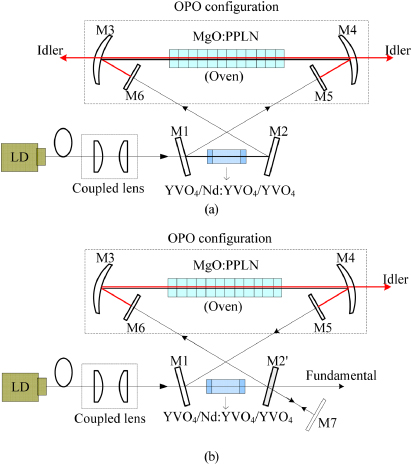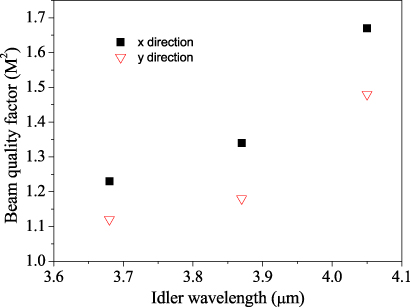Abstract
A continuous-wave (cw), intra-cavity singly resonant optical parametric oscillator (SRO) has been demonstrated. The SRO is based on 5 mol% MgO-doped periodically poled lithium niobate (MgO:PPLN) pumped by a diode-pumped Nd:YVO4 ring laser. For linear polarization operation of the Nd:YVO4 ring laser, the system does not need a polarizer. When unidirectional operation is obtained for the Nd:YVO4 ring laser, the SRO is able to generate light with idler wavelengths ranging from 2.9 to 4.1 μm with a narrow line width. The idler output power is about 470 mW at 3.87 μm with a line width of 0.07 nm.
Export citation and abstract BibTeX RIS
1. Introduction
Optical parametric oscillators (OPOs) are important tunable laser sources in the mid-infrared range that are widely used in laser spectroscopy, atmospheric pollution monitoring, remote detection and differential absorption lidar (DIAL). In particular, continuous-wave (cw) single-frequency mid-infrared laser sources are suitable for high-resolution spectral analysis [1, 2]. For a singly resonant optical parametric oscillator (SRO), only one wave (the signal or the idler) is in resonance within the optical cavity, so the operation of the SRO is stable without mode hopping. Compared with a standing-wave SRO, the traveling-wave SRO has many advantages, such as unidirectional output, fewer axial modes, good frequency stability and narrow line width. In recent years, external-cavity OPOs with excellent results have been reported [3–8]. However, external-cavity cw SROs require high-power pump laser sources with good beam quality. For intra-cavity cw SROs, the SROs are inserted into the cavity of the pump laser and the high pump power intensity in the cavity can be utilized. Therefore, intra-cavity cw SROs do not require pump lasers with high output power and good beam quality [9, 10].
In recent decades, the use of intra-cavity SROs have been proved to be an efficient and low-cost technique to generate cw mid-infrared lasers [11–15]. In 1997, the first cw intra-cavity SRO was reported by Colville [11]. A KTP crystal was used as the nonlinear gain medium in the intra-cavity SRO. The pump laser source was a tunable Ti:sapphire laser. A total output power of 400 mW in the infrared was obtained. Ebrahimzadeh et al theoretically described the operating principles and performance characteristics of cw intra-cavity SROs [12]. They summarized the design criteria of intra-cavity cw SROs, outlined an optimization procedure to increase the down-conversion efficiency and output power, and emphasized the merits of intra-cavity SROs such as low input power requirement, potential for 100% conversion efficiency, high-power operational stability, and power scalability. With the advent of quasi-phase-matching (QPM) materials, QPM technology is developed rapidly. In 2003, an intra-cavity cw SRO based on periodically poled lithium niobate (PPLN) as the nonlinear gain medium was reported [13]. The SRO was placed inside the cavity of a diode-end-pumped Nd:YVO4 ring laser. When the ring laser was operated in a unidirectional mode, more than 520 mW of signal power was obtained. In 2004, a tunable intra-cavity cw PPLN SRO with a double ring configuration was demonstrated [14]. A diode-pumped ring-cavity Nd:YAG laser was used as the pumping source. The idler tunable range was from 2.3 to 3.9 μm. The output line width was less than 15 MHz.
2. Experimental setup
In this letter, we demonstrate a compact intra-cavity cw singly resonant optical parametric oscillator (SRO) based on MgO:PPLN crystal. The SRO with a four-mirror configuration is inserted into the cavity of a Nd:YVO4 ring laser. The compact optical layout for the SRO system is shown in figure 1(a). The pump source of the SRO is a diode-pumped Nd:YVO4 ring laser. A simple bow-tie ring-cavity configuration is used in the Nd:YVO4 laser. The ring laser comprises two flat mirrors (M1 and M2) and two curved mirrors (M3 and M4) whose curvature radius is 200 mm. The two flat mirrors (M1 and M2) have high transmission at the laser diode (LD) wavelength (T > 95%@808 nm) and high reflectivity at the fundamental laser wavelength (R > 99.8%@1064 nm), and mirrors M3 and M4 are coated for high reflectivity at the fundamental wavelength (R > 99.5%@1064 nm). The total physical length of the ring resonator is about 610 mm. The gain medium of the ring laser is YVO4/Nd:YVO4/YVO4 composite crystal. The composite crystal, with two 2-mm-long undoped YVO4 ends bonded to the faces of 0.3 at.% Nd:YVO4, has dimensions of 3 mm × 3 mm × 20 mm, is located at the mid-point of the resonator arm between the flat mirrors (M1 and M2). Both end faces of the laser crystal are antireflection coated at 1064 and 808 nm, and the laser crystal is wrapped with indium foil and mounted in a water-cooled copper heat-sink maintained at 17 °C to allow efficient removal of waste heat. The pump source of the Nd:YVO4 ring laser is a fiber-coupled laser diode (LD) whose central wavelength is 807.5 nm at 29 °C, and the output wavelength can be tuned by controlling the LD temperature. The LD beam is coupled by a fiber with a core diameter of 400 μm and a numerical aperture of 0.22. The maximum output power of the LD is 30 W. The LD output is shaped and focused by a series of convex lenses.
Figure 1. The optical layout for the SRO experiment: (a) the Nd:YVO4 ring laser operates in bidirectional mode; (b) the Nd:YVO4 ring laser operates in unidirectional mode.
Download figure:
Standard imageThe SRO is inserted into the cavity of the Nd:YVO4 ring laser, which is a four-mirror linear configuration consisting of two identical curved cavity mirrors (M3 and M4) and two flat mirrors (M5 and M6). In the configuration, the shared curved cavity mirrors (M3 and M4) are high reflectivity at the fundamental laser wavelength and signal wavelengths (R > 99.5%@1.06 μm, R > 99.5%@1.4–1.7 μm), and high transmission at the idler wavelengths (T > 95%@3–5 μm). The two flat mirrors (M5 and M6) are antireflection coated at the fundamental laser wavelength (T > 99%@1.06 μm), and high reflectivity at the signal wavelengths (R > 99.8%@1.4–1.7 μm). The SRO configuration gives a singly resonant OPO, which is resonant for the signal frequency. The physical length of the SRO is about 240 mm. The nonlinear crystal in this SRO is 5 mol% MgO-doped periodically poled lithium niobate (MgO:PPLN, HC Photonics), which has dimensions of 1 mm × 8 mm × 50 mm. It contains seven domain periods from 28.5 to 31.5 μm. It is antireflection coated for the signal wavelengths (R < 1%@1.4–1.7 μm), idler wavelengths (R < 1%@3–5 μm), and fundamental wavelength (R < 1%@1.06 μm). The nonlinear crystal is mounted in a temperature controlled oven with a temperature stability of ±0.1 °C, in which the crystal temperature can be kept in the range of 25–200 °C. The nonlinear crystal is located at the beam waist of the symmetric ring laser, so good mode matching of the fundamental, signal and idler beam can be achieved by optimizing the system.
The gain medium is c-cut Nd:YVO4 crystal, which keeps linear polarization output of the ring laser. By adjusting the Nd:YVO4 crystal, the polarization of the fundamental laser can be set parallel to the z-axis of the MgO:PPLN crystal to access the largest nonlinear tensor coefficient d33. The polarizer and half wave plate are not necessary in this configuration, so the insertion loss can be avoided.
3. Experimental results
In this experiment, the temperature of the MgO:PPLN is controlled at 120 °C. When the SRO operates in bidirectional mode (figure 1(a)), the idler output power in each direction is almost equal for free operation of the Nd:YVO4 ring laser. The signal and idler wavelengths of the cw SRO are recorded with a laser spectrum analyzer (EXFO WA-650) combined with a wavelength meter (EXFO WA-1500) at three grating periods of 29.5, 29 and 28.5 μm. The idler wavelengths are 3.68 μm, 3.87 μm and 4.05 μm respectively, and the corresponding signal wavelengths are 1.49 μm, 1.46 μm and 1.43 μm. Figure 2 shows the idler output power versus the LD power. The maximum idler output power is about 850 mW at 3.68 μm, 690 mW at 3.87 μm and 410 mW at 4.05 μm. With the increase of LD input power, the thermal lens effect of the laser crystal and nonlinear crystal is getting more and more remarkable, which brings about mode mismatch in the cavity. This could be a reason for the decrease of idler output power.
Figure 2. Idler output power versus input power from the LD when the operation of the ring laser is bidirectional.
Download figure:
Standard imageTo obtain an idler output with a narrow line width, the ring laser should operate in unidirectional mode. In this configuration, an output coupler M2' with a transmissivity of 5% at the fundamental laser wavelength is used in place of flat mirror M2 (figure 1(b)). The retro-reflector mirror M7 (R > 99.8%@1.06μm) is utilized to keep unidirectional operation of the ring laser, and spatial hole burning of the standing-wave cavity is eliminated. Thus single-frequency operation of the ring laser can be achieved. In addition, the output power of the fundamental laser from the ring laser can be measured, and the power in the cavity can be estimated. Figure 3 shows the 3.87 μm idler output power and the fundamental laser power in the cavity versus the input power from the LD. When the LD input power is 25 W, the 3.87 μm idler output power is about 470 mW and the output fundamental laser power is about 2.35 W. The conversion efficiency of the 3.87 μm idler is estimated to be about 21.5% with respect to the fundamental laser. The spectral output of the SRO can be recorded with a laser spectrum analyzer (EXFO WA-650) combined with a wavelength meter (EXFO WA-1500). Figure 4 shows the optical spectrum of the SRO idler for a period of Λ = 29 μm at a crystal temperature of 120 °C. The line width of the 3.87 μm idler is about 0.07 nm.
Figure 3. The 3.87 μm idler output power and the fundamental laser power in the cavity versus the input power from the LD.
Download figure:
Standard imageFigure 4. The output idler wavelength of the intra-cavity MgO:PPLN SRO at a temperature of T = 120 °C for the domain period Λ = 29 μm.
Download figure:
Standard imageThe SRO idler beam quality is also measured as a function of the idler power and idler wavelength. By making use of the knife-edge method, the idler beam radius for the SRO as function of the distance from the focusing lens is found. By using the nonlinear fitting method, the beam quality factor M2 can be obtained. For an idler output power of 300 mW at 3.68, 3.87 and 4.05 μm, the value of M2 is shown in figure 5.
Figure 5. Beam quality factor (M2-factor) versus idler wavelength.
Download figure:
Standard image4. Conclusions
In this paper, we have demonstrated a compact intra-cavity cw MgO:PPLN SRO pumped by an LD-pumped Nd:YVO4 ring laser. The symmetrical design of the system can achieve mode matching easily. By shifting the MgO:PPLN crystal to make the fundamental beam pass through different poled periods, with temperature tuning of the nonlinear crystal, the SRO is able to generate idler light ranging from 2.9 to 4.1 μm. When the Nd:YVO4 ring laser operates in a unidirectional mode, an idler with a narrow line width is obtained from the intra-cavity SRO. For an input power of 25 W from the LD, 470 mW idler output power at 3.87 μm with a line width of about 0.07 nm is obtained. The intra-cavity SRO can be used in high-resolution spectroscopy.
Acknowledgments
This research work is supported in part by the Program for New Century Excellent Talents in University (NCET-11-269), by the Fundamental Research Funds for the Central Universities (HEUCFZ1217, HEUCFZ1221) and by the Natural Science Foundation of China (61275138).






